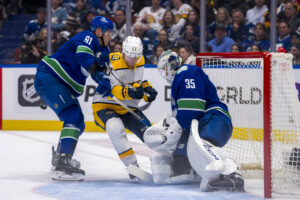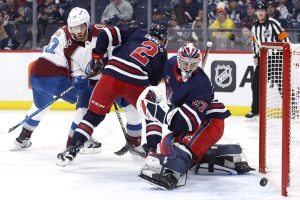The History of Trade is a mini series going through each team’s best and worst trades of all time. Each team has their own history and some may cross over, but the series will try to stick to each team. This article will focus on the Colorado Avalanche trade history, finding the best and worst of all time.
Colorado Avalanche Trade History
The Mile High City is no stranger to big trades. Even the friendly shore of Quebec City had its fair share of players come and go via the trade route. The two-time Stanley Cup champion franchise has one of the most storied histories in the league, and as such has more than one of the biggest trades all time.
Best Trade
Colorado and, in earlier years, Quebec never had any problem targeting big trades. This of course is the franchise that acquired the draft pick that turned into Joe Sakic for two aging veterans. But no matter how great that trade looked, it doesn’t even crack the top two in franchise history. But the biggest trade in franchise history may have just pushed them to their first Stanley Cup.
The Trade
Colorado acquires Patrick Roy and Mike Keane from Montreal for Andrei Kovalenko, Martin Rucinsky, and Jocelyn Thibault.
Traded Away
The Montreal Canadiens were in a very tough spot in December of 1995. Patrick Roy was demanding a trade out of La Belle Province, and the entire league knew it. It took all of four days for the Canadiens to move Roy to Denver. The return for them was much less than expected. Martin Rucinsky managed to be an okay, if you can even say that, piece in the deal. After arriving in Montreal, Rucinsky put up 25 goals and 60 points across the remaining 56 games that season. He followed that campaign up with back-to-back 20-goal seasons, topping out at 55 points. When his Montreal career was over, Rucinsky had put up 134 goals and 297 points across parts of seven seasons. No matter how good those numbers are they are looked at as a negative in regards to this trade.
Andrei Kovalenko, the other forward in the deal, managed to only put up 34 points in his half season with the Canadiens. After the 1994-95 season Kovalenko was sent to Edmonton in exchange for Scott Thornton.
Kovalenko’s bad stint with the Canadiens was not the only one from this trade though. The goaltender the Canadiens acquired would never reach the heights of the departed Roy. Arriving as the backup from Colorado, Thibault was thrust into the starters role in Montreal and, to his credit, held his own. He would finish the year with 23 wins in 40 games. He would last two more full seasons in Montreal with some success during the regular season. Unfortunately for the Canadiens, Thibault was never able to translate his regular season success to the playoffs. Across 11 playoff games for the Canadiens, Thibault only managed two wins. He carried a 3.18 goals-against-average and an .885 save percentage across his three playoff series.
Thibault was eventually traded during the 1998-99 season to Chicago along with Dave Manson and Brad Brown for a myriad of players and a draft pick. His time in Montreal will always be remembered as the goalie traded for Roy. Thibault faced an impossible task and never lived up to the hopes.
The Return
Everyone knows the impact Roy had on the Avs, but he wasn’t the only big name acquired in this trade. Mike Keane was the Canadiens captain prior to being traded. He was struggling through a tough year in Montreal which made him expendable in the trade. Though he managed to only add ten goals the rest of the season, Keane was much more valuable than that. His leadership was apparent from the moment he walked through the dressing room doors. Joining the likes of Sakic and Peter Forsberg as the teams go to leaders, Keane helped lead the team into the playoffs. Although only managing to stay in Denver for two seasons, Keane will always be remembered because of the trade.
But the real key to this trade was and will always be Roy. The two-time Stanley Cup champion in Montreal, Roy joined the Avs in the midst of a good season. Prior to Roy arriving the Avs were sitting at 16-7-4. Roy would actually go on to lose his first game for the Avalanche. He would not be held down for long though. He would finish the regular season with 22 wins, leading the Avs to a first place finish in the Pacific Division.
The playoffs turned into Roy’s ability to endear himself to the Avs faithful for life. Along with Burnaby Joe and Peter Forsberg, Roy led the young Colorado team to the Stanley Cup Final in their first season in Denver. The playoff run would end there, but not before the Avs won four more games. For his effort Roy finished the postseason with an insane .921 save percentage and a miniscule 2.10 goals-against-average.
The Avalanche would go on to make the playoffs in every single season that Roy manned the crease. Roy spent the remainder of his career in Denver and became arguably the greatest goalie in the history of the game. His numbers in Montreal were never bad, posting a 2.77 goals-against-average and a .904 save percentage. His numbers in Colorado were even better. Across eight seasons Roy posted a staggering 2.27 goals-against-average and a .918 save percentage in the regular season. But just as in his first year in Colorado, his numbers managed to get even better in the playoffs. He posted a ridiculous .922 save percentage and 2.25 goals-against-average in 133 playoff games.
When all was said and done, Roy would add another Stanley Cup while in Colorado, winning the Conn Smythe that season as well. That Conn Smythe would put Roy in elite company, becoming the only player in NHL history to win the trophy three times. Even though he never managed to win a Vezina Trophy while playing for Colorado (all three of his Vezina’s came in Montreal), he was arguably one of the best goaltenders almost every season. When Roy retired he held the all-time wins record for goaltenders in both the regular season and postseason. The Avalanche would retire his number the season after he retired, and later the Canadiens would retire his number, five years later. He entered the Hall of Fame in 2006 and was named to the NHL’s Top 100 players list last season.
Without the trade the NHL outlook may have been much different. The Canadiens could have become a powerhouse in the East. Instead they missed the playoffs on five separate occasions and only made it out of the first round twice, losing in the Conference Finals on both occasions. The Avalanche managed to make the Conference Finals in six of the eight seasons Roy played for them.
Honourable Mentions: Colorado/Quebec trades Eric Lindros to the Philadelphia Flyers for Peter Forsberg, Steve Duchesne, Ron Hextall, Kerry Huffman, Mike Ricci, 1993 first round pick (Jocelyn Thibault), Future Considerations (Chris Simon and 1994 first round pick (Nolan Baumgartner)); Colorado trades Dale Hunter and Clint Malarchuk to Washington for Gaetan Duchesne, Alan Haworth and 1987 first round pick (Joe Sakic); Colorado acquires Rob Blake and Steve Reinprecht from Los Angeles for Adam Deadmarsh, Aaron Miller, 2001 first round pick (David Steckel), 2003 first round pick (Brian Boyle), and a player to be named later (Jared Aulin); Colorado acquires Dave Andreychuk and Ray Bourque from Boston for Martin Grenier, Samuel Pahlsson, Brian Rolston and 2000 first round pick (Martin Samuelsson)
Worst Trade
For a team who is not shy to trade big names, the Avalanche have managed to avoid making many terrible deals. A few trades in team history could be considered bad. Some pieces that were moved left fans wondering what could those players have done wearing the maroon and blue (or white and blue in Quebec). But the worst saw one of the best Swedish players in NHL history switch blues.
The Trade
Colorado trades Mats Sundin, Garth Butcher, Todd Warriner, and 1994 first round pick (Nolan Baumgartner) to the Toronto Maple Leafs for Wendel Clark, Sylvain Lefebvre, Landon Wilson, and 1994 first round pick (Jeff Kealty)
Traded Away
The draft pick that Colorado traded to Toronto was ironically from one of the best trades in team history. They acquired the pick from Philadelphia for Eric Lindros. But Toronto would not hold on to the pick for very long, flipping it to Washington in a separate deal.
Garth Butcher would only play one season in Toronto, surviving on the last legs of his career. In 45 games he would put up a dismal eight points. But Butcher was never a main piece of this deal.
Warriner on the other hand, would have some success in Toronto. He never lit the league on fire, but Warriner would turn into a solid NHL player. He played five seasons in Toronto, putting up a modest 84 points. His career high in points would come with the Leafs in 1996-97 when he managed to put up 12 goals and 33 points in 75 games. He was eventually traded to Tampa Bay for the third round pick that turned into Mikael Tellqvist.
This trade though will always be about one player, Mats Sundin. Prior to being traded Sundin had already shown the league that he was an elite young talent. Four seasons in Quebec City saw Sundin put up 23-or-more goals every year, topping out at 47. He would also put up a career high 114 points in 1992-93 while in Quebec. Trading him away was not an easy move for Quebec.
But after arriving in Toronto Sundin instantly became a leader. Despite a shortened 1994-95 season, Sundin was still able to put up 47 points in 47 games, while scoring 23 goals of course. Sundin would go on to play for 13 seasons in Toronto, never scoring less than 23 goals. He would be named captain after Doug Gilmour was traded to the New Jersey Devils in the 1996-97 season. Sundin would wear the ‘C’ every year after that, becoming the epitome of a leader in the NHL. He would speak to the media and his teammates like there was never any pressure. He led the Leafs in scoring in eight consecutive years at one point, having his streak broken by Alexander Mogilny in 2002-03.
After the 2007-08 season the Leafs decided to try and do right by Sundin, who had never been to the Stanley Cup Finals, by trading him to a contender at the time. He signed with the Vancouver Canucks, without a fight from the Leafs brass. Unfortunately for Sundin he would struggle in his only season on the West Coast, putting up his lowest goals and points totals of his career. He would retire following that season, but his career will always be known for his time with the blue and white. He would finish as the franchise’s all-time leader in both goals and points, while sitting second in assists behind the Hall of Famer Borje Salming. His number would be retired by the Leafs in 2012. Sundin was inducted into the Hall of Fame as the second Swedish born player ever after the aforementioned Salming.
The Return
For a player with the skill level of Sundin at the time of the trade you would expect some decent pieces in return. The Avs really weren’t able to get a fair return on this trade though. The draft pick Quebec acquired would turn into Jeff Kealty. Kealty never ended up playing a single game in the NHL. His highest level of pro hockey would be the IHL for the Milwaukee Admirals.
Landon Wilson would not fair much better for Colorado as he only managed to sneak into 16 games during his time in Denver. He was traded the next season to the Boston Bruins along with Anders Myrvold for Boston’s first round pick in the 1998 draft. That pick would turn into Robyn Regehr, which may have been the best outcome for the Avs.
Sylvain Lefebvre ended up having the biggest impact on the scoresheet for the Colorado organization. He also ended up being the longest serving player out of the trade, which says a lot about the return. Lefebvre managed to stay with the team for five seasons. He would play in a total of 351 games, never playing fewer than 71 in a regular length season. When Lefebvre’s time in Colorado was done he had put up a total of 72 points. This total may not jump off the page but as a defenseman Lefebvre was a decent piece in an otherwise sad deal.
The biggest name returning to the Avs was supposed to be Wendel Clark. A fan favourite in Toronto, Clark arrived with high expectations in Quebec. Unfortunately he was not able to live up to them. Clark managed to only stay in Quebec for one season, racking up 12 goals and 30 points in the lockout shortened 1994-95 season. Clark was traded during the off-season to the New York Islanders for Claude Lemieux. In a twist of fate, Lemieux may have been the best acquisition from the Sundin trade for Colorado. He was able to put up 212 points across 297 games for the Avalanche. Lemieux managed to outscore all four players acquired in the original trade.
Had Colorado/Quebec kept the young and talented Sundin they may have become a dynasty in the Western Conference. Colorado would win two Stanley Cups while Sundin was still playing. He may have been able to help them win a few more. But due to the move, Colorado fans are left to wonder what could have been.
Dishonourable Mentions: Colorado trades Chris Drury along with Stephane Yelle to the Calgary Flames for Derek Morris, Jeff Shantz, and Dean McAmmond; Colorado trade Alex Tanguay to the Calrgary Flames for Jordan Leopold, 2006 second round pick (Codey Burki), and 2007 conditional pick (Brian Day)
Main Photo:






